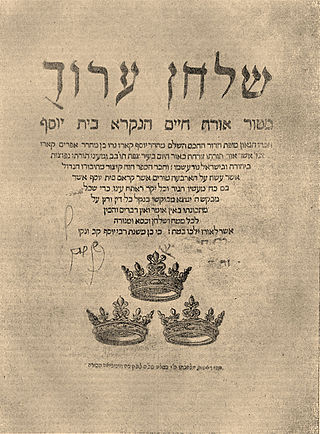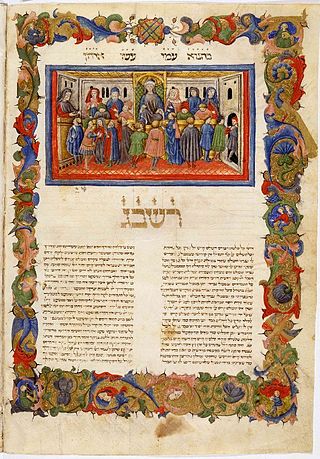Halakha, also transliterated as halacha, halakhah, and halocho, is the collective body of Jewish religious laws that are derived from the Written and Oral Torah. Halakha is based on biblical commandments (mitzvot), subsequent Talmudic and rabbinic laws, and the customs and traditions which were compiled in the many books such as the Shulchan Aruch. Halakha is often translated as "Jewish law", although a more literal translation of it might be "the way to behave" or "the way of walking". The word is derived from the root which means "to behave". Halakha not only guides religious practices and beliefs, it also guides numerous aspects of day-to-day life.
Asher ben Jehiel was an eminent rabbi and Talmudist best known for his abstract of Talmudic law. He is often referred to as Rabbenu Asher, “our Rabbi Asher” or by the Hebrew acronym for this title, the Rosh. His yahrzeit is on 9 Cheshvan.

Rabbinic literature, in its broadest sense, is the entire spectrum of rabbinic writings throughout Jewish history. However, the term often refers specifically to literature from the Talmudic era, as opposed to medieval and modern rabbinic writings, and thus corresponds with the Hebrew term Sifrut Chazal. This more specific sense of "Rabbinic literature"—referring to the Talmudim, Midrashim, and related writings, but hardly ever to later texts—is how the term is generally intended when used in contemporary academic writing. The terms mefareshim and parshanim (commentaries/commentators) almost always refer to later, post-Talmudic writers of rabbinic glosses on Biblical and Talmudic texts.

The Shulchan Aruch, sometimes dubbed in English as the Code of Jewish Law, is the most widely consulted of the various legal codes in Judaism. It was authored in Safed, Ottoman Syria by Joseph Karo in 1563 and published in Venice two years later. Together with its commentaries, it is the most widely accepted compilation of halakha or Jewish law ever written.

Arba'ah Turim, often called simply the Tur, is an important Halakhic code composed by Yaakov ben Asher. The four-part structure of the Tur and its division into chapters (simanim) were adopted by the later code Shulchan Aruch. This was the first book to be printed in Southeast Europe and the Near East.

Moses Isserles, also known by the acronym Rema, was an eminent Polish Ashkenazi rabbi, talmudist, and posek.

Orach Chayim, is a section of Rabbi Jacob ben Asher's compilation of Halakha, Arba'ah Turim. This section addresses aspects of Jewish law pertinent to the Hebrew calendar. Rabbi Yosef Karo modeled the framework of the Shulkhan Arukh, his own compilation of practical Jewish law, after the Arba'ah Turim. Many later commentators used this framework, as well. Thus, Orach Chayim in common usage may refer to another area of halakha, separate from Rabbi Jacob ben Asher's compilation.
Yoreh De'ah is a section of Rabbi Jacob ben Asher's compilation of halakha, Arba'ah Turim around 1300. This section treats all aspects of Jewish law not pertinent to the Hebrew calendar, finance, torts, marriage, divorce, or sexual conduct.. Yoreh De'ah is therefore the most diversified area of Jewish law. Later, Rabbi Yosef Karo modeled the framework of his own compilation of practical Jewish law, the Shulchan Aruch, after the Arba'ah Turim. Many later commentators used this framework, as well. Thus, Yoreh De'ah in common usage may refer to an area of halakha, non-specific to Rabbi Jacob ben Asher's compilation.
Samson ben Abraham of Sens ,was one of the leading French Tosafists in the second half of the 12th and the beginning of the 13th centuries. He was the most outstanding student and the spiritual heir of Rabbi Isaac ben Samuel ha-Zaken. He is referred also known as "the Rash" or "the Prince of Sens", and within Tosafot as "Rashba".
Meir ben Todros HaLevi Abulafia, also known as the Ramah, was a major Sephardic Talmudist and Halachic authority in medieval Spain.
Yaakov ben Yaakov Moshe Lorberbaum of Lissa (1760-1832) was a rabbi and posek. He is most commonly known as the "Ba'al HaChavas Da'as" or "Ba'al HaNesivos" for his most well-known works, or as the "Lissa Rav" for the city in which he was Chief Rabbi.
Joseph Escapa served in the rabbinate of İzmir. He was probably born at Skopje, Ottoman Empire back then, after which he is named.
David Abudarham, referred to as Abudarham, Abudraham, or Avudraham, was a rishon who lived in Seville in the 14th century and was known for his commentary on the siddur.
Judah ben Asher was a German Talmudist and later rabbi of Toledo, Spain, son of Rabbenu Asher and brother of Jacob ben Asher.
Jewish commentaries on the Bible are biblical commentaries of the Hebrew Bible from a Jewish perspective. Translations into Aramaic and English, and some universally accepted Jewish commentaries with notes on their method of approach and also some modern translations into English with notes are listed.
Beit Yosef, written by Rabbi Joseph Karo, is a long and detailed commentary on the Halakhic code Arba'ah Turim ("Tur") by Jacob ben Asher. The Shulchan Aruch, which Rabbi Karo wrote later in his life, is a condensation of its rulings.
The mixture of meat and dairy is forbidden according to Jewish law. This dietary law, basic to kashrut, is based on two verses in the Book of Exodus, which forbid "boiling a (goat) kid in its mother's milk" and a third repetition of this prohibition in Deuteronomy.

Sifrei Kodesh, commonly referred to as sefarim, or in its singular form, sefer, are books of Jewish religious literature and are viewed by religious Jews as sacred. These are generally works of Torah literature, i.e. Tanakh and all works that expound on it, including the Mishnah, Midrash, Talmud, and all works of halakha, Musar, Hasidism, Kabbalah, or machshavah. Historically, sifrei kodesh were generally written in Hebrew with some in Judeo-Aramaic or Arabic, although in recent years, thousands of titles in other languages, most notably English, were published. An alternative spelling for 'sefarim' is seforim.
The following outline is provided as an overview of and topical guide to Judaism:






